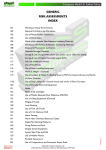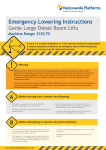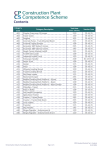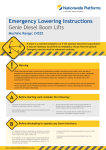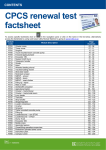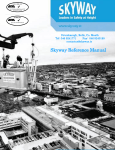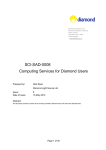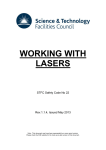Download THE RISK PRIORITY ASSESSMENT METHOD (RPA)
Transcript
RISK MANAGEMENT AND THE THE RISK ASSESSMENT METHOD STFC TRAINING MANUAL Rev 1.4, Issued May 22, 2012 Author: G J Baker Issue No: 1.4 Issue Date: 22/05/2012 Page 2 of 16 CONTENTS INTRODUCTION ...................................................................................... 3 FLOW CHART .......................................................................................... 5 FIVE STEPS ............................................................................................. 6 MANAGING RISKS...................................................................................15 RISK CATEGORISATION ..........................................................................16 STANDARD PRO FORMA .......................................................................... 17 QUANTITATIVE PRO FORMA.................................................................... 18 Author: G J Baker Issue No: 1.4 Issue Date: 22/05/2012 Page 3 of 16 INTRODUCTION What is a Risk Assessment? Legally, as an employer, you have to assess risks. A risk assessment is nothing more than a careful examination of what in your workplace could cause harm to: • your employees; • members of the public; or • anyone else (like a visitor for example). What is it for? In effect, a risk assessment allows you to identify: • What could go wrong • How badly it could go wrong; • How likely it is to happen; and • Whether anything needs to be done about it. There are probably a number of different things that could go wrong in your workplace, causing some sort of harm to someone else. These are HAZARDS. Hazard and Risk A HAZARD is anything that has the potential to cause harm, be it a thing like electricity or a slippery floor, or an activity, like working from a height or working with and arc welder. A RISK is the chance, great or small, that people will be harmed by the hazard, together with an indication of how serious the harm could be. Author: G J Baker Issue No: 1.4 Issue Date: 22/05/2012 Page 4 of 16 Author: G J Baker Issue No: 1.4 Issue Date: 22/05/2012 Page 5 of 16 THE FIVE STEP RISK METHOD Assessing the Risks The ‘five steps’ method of Risk Assessment provides a simple way of thinking about risks. The method helps you consider: 1. how particular types of accident could happen in your workplace or as a result of carrying out any particular task or activity; 2. how likely they are to happen and to who; 3. the nature of the risk and what precautions to take; and 4. what to do with the results. The method can also be used to identify a ‘risk category’ for each of the hazards that have been identified. The risk category can help you identify which hazards to deal with first. The higher the ‘risk category’ the bigger the potential problem. What Next? Carefully follow the steps on the following pages to complete your assessment. These steps are: • Step 1: ‘What are the hazards’; • Step 2: ‘Decide Who might be Harmed and How’; • Step 3: ‘What further action is necessary’; • Step 4: ‘How will you put the Assessment into action’; and • Step 5: ‘Review and Update the Assessment’ There is a form provided at the back to use as a template for Steps 1 and 2. A central database is available for you to record the results of the assessment and to manage the actions from the assessment. Managing the Risks After Step 2, you may end up with a number of actions that you need to prioritise, you may have to manage the actions from a number of assessments or you may have a complex project to manage. In any case you probably need a more quantitative assessment method that can be applied equally across all the actions to enable you to plan and prioritise the implementation of the actions. The final section shows how you can use the information from the assessments to categorise the actions in a quantitative way. Author: G J Baker Issue No: 1.4 Issue Date: 22/05/2012 Page 6 of 16 Step 1: ‘What are the Hazards?’ Firstly, make sure you have copies of the assessment form that appears at the back of this document. Then decide the scope of the assessment. You may wish to assess the hazards within a particular work area, or for a particular task or activity. Below is a list of common hazards. The list is not exhaustive but is designed to help you think about possible hazards in the work area, task or activity. Hazards Drowning or asphyxiation Fall from height Trapped by something collapsing/overturning Contact with electricity or electrical discharge Exposure to an explosion Struck by moving vehicle Use of Visual Display Units (*) Contact with moving machinery Exposure to ionising or non-ionising radiation (*) Exposure to Fire Slip, trip or fall on same level Struck by moving, including falling/flying, object Exposure to or contact with a harmful substance (*) Strike against something fixed or stationary Injured by animal Acts of violence Injured while handling, lifting or carrying (*) (*) Assessments for these types of hazards are covered by specific codes. You should consult the relevant documentation if these hazards exist in the area, task or activity. Working down the list, begin by thinking about the first hazard that applies to your workplace situation in the relevant column of your form. For example this might be ‘fall from height’. Now think about any task or step in a task that could feasibly cause this type of accident and result in harm to someone. These should each be given a box in the relevant column of your assessment form (see example below). N.B. You will find that your employees and their representatives can probably add to your list. The more widely you consult, the more complete the assessment will be. Hazard Fall from height ditto Manual Handling Task/Situation Changing light bulbs in ceiling Climbing on fragile roof Carrying heavy packages Once you have exhausted all of the options for the first hazard move onto the next one that applies to your workplace and repeat the process. Keep working your way down the list in this way until you have identified all of the potential causes of each of the different accident types. Author: G J Baker Issue No: 1.4 Issue Date: 22/05/2012 Page 7 of 16 The example form below shows the kind of information you might have entered by the end of STEP 1. This uses a few examples from consideration of the hazards present in a workshop. We will keep completing this form as we go through the other steps in the assessment. Ref: Description: Warehouse/Store Assessment Date: Location/Site: Assessor: Department: Assessment Team: Persons Exposed: Activity/Task: Step 1: What are the Hazards? Step 2: Who might be harmed and how? What are you already doing? Step 3: What further action is necessary? ___________________ __________________ __________________ __________________ Step 4: How will you put the Assessment into action? Action by who Hazard/Task or Situation by when Done Fall from height/ Changing light bulb in high ceiling Fall from Height/ Climbing on fragile roof Manual Handling/ Carrying heavy packages Step 5 Review date: Author: G J Baker Review you assessment to make sure you are still improving, or at least not sliding back. If there is significant change in your workplace, remember to check your assessment and, where necessary, amend it. Issue No: 1.4 Issue Date: 22/05/2012 Page 8 of 16 Step 2: ‘Decide Who Might be Harmed and How’ For each of the hazards identified in STEP 1 you need to be clear about who might be harmed. You only need to identify groups of people: Staff working in the area Staff walking through the area Staff with particular needs (Young people, pregnant women, …) Contractors (maintenance workers and cleaners in the area) Members of the public (who may have access to the area) The next thing to consider is the type of injury/illness that would result if what COULD happen DID happen. In STEP 1 you identified a number of things that could cause harm to someone in your workplace. For each hazard you identified, think about the type of injury/illness that is most likely. Do this by beginning at the top of the list of types of accident and working your way down. As soon as you come to the phrase that best describes the general type of injury/illness, use this phrase in your form to help you describe how someone might be harmed. As a general rule you are looking for ‘the most likely reasonably foreseeable injury’ not just the worst case. Decide How Someone Might be Harmed Death Causing Permanent disability (Loss of limb, hearing, major burns) Causing Temporary Disability (Fractures, intermediate burns) Causing Significant Injuries (Sprains, minor burns) Causing Minor Injuries (e.g. cuts / scratches) You should also note what you are already doing to reduce the hazard or make the harm less serious. Author: G J Baker Issue No: 1.4 Issue Date: 22/05/2012 Page 9 of 16 At the end of STEP 2 you should have a form that looks something like the one below. Ref: Description: Warehouse/Store Assessment Date: Location/Site: Assessor: Department: Assessment Team: Persons Exposed: Activity/Task: Step 1 What are the Hazards? Step 2 Who might be harmed and how? What are you already doing? Step 3: What further action is necessary? ___________________ __________________ __________________ __________________ Step 4: How will you put the Assessment into action? Action by who Hazard/Task or Situation Fall from height/ Changing light bulb in high ceiling Staff could suffer fatal injury Use of MEWP Fall from Height/ Climbing on fragile roof Member of staff may break a limb Nothing Manual Handling/ Carrying heavy packages Staff could suffer back problems Lifting aids available. Step 5 Review date: Author: G J Baker by when Done Review you assessment to make sure you are still improving, or at least not sliding back. If there is significant change in your workplace, remember to check your assessment and, where necessary, amend it. Issue No: 1.4 Issue Date: 22/05/2012 Page 10 of 16 Step 3: ‘What Further Action is Necessary?’ When considering what action may be required to reduce the risk from any particular hazard, the following principles should be considered, if possible in the order given: 1. Eliminate the hazard completely; 2. Replace with a less hazardous option; 3. prevent access to the hazard (e.g. by guarding); 4. organise the work to reduce exposure to the hazard; 5. issue personal protective equipment; 6. provide welfare facilities (e.g. washing facilities for removal of contamination and first-aid); In all cases information and training should be provided. Be sure to involve staff, this will ensure that any actions you propose will work in practice and won’t give rise to any new hazards. At this point you can transfer the information to the central risk assessment database. This will enable you to manage the actions and prioritise them as required. Note what actions need to be taken. You need to do everything ‘reasonably practicable’ to protect people from the harm (i.e. taking into account the cost and effort needed to reduce the risk against its likelihood of occurrence and potential severity) and then manage any residual risk. It is not required to reduce risk to zero.. Ref: Description: Warehouse/Store Assessment Date: Location/Site: Assessor: Department: Assessment Team: Persons Exposed: Activity/Task: Step 1 What are the Hazards? Step 2 Who might be harmed and how? What are you already doing? Step 3: What further action is necessary? ___________________ __________________ __________________ __________________ Step 4: How will you put the Assessment into action? Action by who Hazard/Task or Situation Fall from height/ Changing light bulb in high ceiling Staff could suffer fatal injury Use of MEWP None Fall from Height/ Climbing on fragile roof Member of staff may break a limb Nothing Control access to roof. Place warning signs. Manual Handling/ Carrying heavy packages Staff could suffer back problems Lifting aids available. None Step 5 Review date: Author: G J Baker by when Done Review you assessment to make sure you are still improving, or at least not sliding back. If there is significant change in your workplace, remember to check your assessment and, where necessary, amend it. Issue No: 1.4 Issue Date: 22/05/2012 Page 11 of 16 Step 4: ‘How will you put the Assessment into Action?’ By doing this assessment you have identified: • all of the things that could cause harm in your workplace; • what the resulting injuries/illnesses are likely to be; and • what you are going to do about them. We suggest that you look at your form and identify which of the hazards that you will probably need to worry about most as they are likely to: 1. happen 2. cause severe injuries/illnesses; Armed with this information, you can prioritise your response to the workplace health and safety issues that are most important in your particular situation. In terms of what to do to reduce these risks, every situation and hazard is different. For each of the hazards think about how you could reduce either: • the likelihood; or • the level of injury/illness. There may be some things that you can do that will reduce both. It is important to look at all of the hazards in this way. Some hazards, while perhaps not being of the highest priority in terms of the risk, may be very easily and cheaply dealt with. Other hazards might also be of a lower priority in terms of risk but may be very difficult and expensive to deal with. In such cases it is probably better to deal with the more ‘important’ (and perhaps more cheaply dealt with) hazards first. By doing this you will ensure that all of your health and safety efforts are directed efficiently so that you can achieve maximum health and safety benefits at least cost/effort. For each of the ‘priority hazards’ map out what you are going to do by recording: • what you intend to do about it; • when you intend to do it; and • who is going to do it. Keep revisiting your assessment and recording the changes that you have made. By doing this you will have an ‘at a glance’ record of what risks are the most important in your workplace at any one time. Author: G J Baker Issue No: 1.4 Issue Date: 22/05/2012 Page 12 of 16 Ref: Description: Warehouse/Store Assessment Date: Location/Site: Assessor: Department: Assessment Team: Persons Exposed: Activity/Task: Step 1 What are the Hazards? Step 2 Who might be harmed and how? What are you already doing? Step 3: What further action is necessary? ___________________ __________________ __________________ __________________ Step 4: How will you put the Assessment into action? Action by who Hazard/Task or Situation Fall from height/ Changing light bulb in high ceiling Staff could suffer fatal injury Use of MEWP None N/A Fall from Height/ Climbing on fragile roof Member of staff may break a limb Nothing Control access to roof. Place warning signs. ABC Manual Handling/ Carrying heavy packages Staff could suffer back problems Lifting aids available. None N/A Step 5 Review date: Author: G J Baker by when Done 1/1/08 Review you assessment to make sure you are still improving, or at least not sliding back. If there is significant change in your workplace, remember to check your assessment and, where necessary, amend it. Issue No: 1.4 Issue Date: 22/05/2012 Page 13 of 16 Step 5: ‘Review and Update’ At some stage you will have to revisit the assessment. New equipment or new substances could introduce new hazards which need to be looked at. In addition if you have an accident or near miss you need to review the assessment in the light of what happened. In any event the assessment should be reviewed at least once every two years. Using the central risk assessment database will enable us to track assessments which need reviewing and issue reminders. Author: G J Baker Issue No: 1.4 Issue Date: 22/05/2012 Page 14 of 16 ‘Managing Risks’ There will be some instances where you may need to assign priorities to actions from an assessment or you may be responsible for managing the actions from a number of assessments. In either case you will need a coherent method for assigning a priority to actions. The Quantitative Risk Assessment pro-forma (see below) gives you this option. There are three additional fields available when entering or editing any task in an assessment: • • • Harm, Likelihood and Risk. For each hazard, you choose options for the Harm and Likelihood categories. Use the information contained in Step 2, categorise the harm that might be caused: As a general rule you are looking for ‘the most likely reasonably foreseeable injury’ not just the worst case. Decide How Someone Might be Harmed Major Fatality. High Amputations; multiple serious injuries; major fractures; major burns. Moderate Lacerations; burns; concussion; serious sprains; minor fractures. Slight Superficial injuries; minor cuts and bruises; eye irritation from dust. Below are the phrases that are used in the risk database to describe the likelihood of something happening and how someone might be harmed: How Likely is it to Happen? The hazard is very rarely experienced and exposure will seldom result in Very Unlikely injury. The hazard is rarely experienced and exposure will seldom result in Unlikely injury. The hazard is persistent but exposure may not always result in injury. Likely The hazard is persistent and exposure will undoubtedly result in injury. Very Likely Then use the matrix below to obtain a ‘risk factor’ from the likelihood and harm categories for each hazard (e.g. if you decided the harm category was ‘moderate’ and the likelihood was ‘unlikely’ the risk factor would be ‘medium’). This risk category is then used to determine what priority should be given to reducing the risk factor for that particular hazard. Author: G J Baker Issue No: 1.4 Issue Date: 22/05/2012 Page 15 of 16 Risk Factor Harm To manually calculate the risk factors use the table below: Major High High V High V High High Med Med High V High Moderate Low Med Med Med Slight Low Low Low Low Very Unlikely Unlikely Likely Very Likely Likelihood Low Risk - No additional controls are necessary unless they can be implemented at very low cost (in terms of time, money and effort). Actions to further reduce these risks can be assigned low priority. Medium Risk - Consideration should be given as to whether the risks can be lowered, where applicable, to a low risk level, but the costs of additional risk reduction measures should be take into account. The risk reduction measures should be implemented within a defined time period. High Risk – Substantial efforts should be made to reduce the risk. Risk reduction measures should be implemented urgently within a defined time period and it might be necessary to consider suspending or restricting the activity, or to apply interim control measures, until this has been completed. Considerable resources might have to be allocated to additional control measures. V High Risk - These risks are unacceptable. Substantial improvements in risk controls are necessary. The work activity should be halted until risk controls are implemented. If it is not possible to reduce risk the work should remain prohibited. Author: G J Baker Issue No: 1.4 Issue Date: 22/05/2012 Page 16 of 16
















